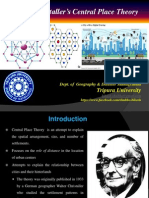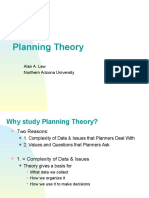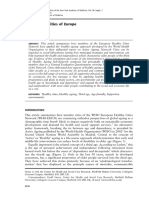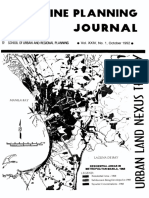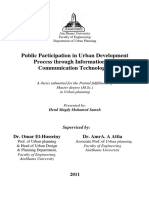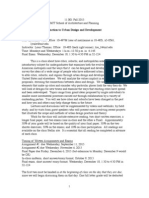100%(1)100% found this document useful (1 vote)
93 viewsCentral Place Theory
Central Place Theory
Uploaded by
တမန္ေတာ္ တမန္ေတာ္Central Place Theory proposes that settlements are arranged in a hexagonal hierarchical pattern to provide goods and services to surrounding areas. German geographer Walter Christaller studied settlement patterns in southern Germany and developed this theory, which assumes an isotropic landscape, evenly distributed population and resources, and that consumers patronize the nearest market. The theory predicts different arrangements depending on whether markets, transportation, or administration are prioritized. It is most applicable to rural areas and helps explain the interconnectedness of human settlements.
Copyright:
© All Rights Reserved
Available Formats
Download as PDF, TXT or read online from Scribd
Central Place Theory
Central Place Theory
Uploaded by
တမန္ေတာ္ တမန္ေတာ္100%(1)100% found this document useful (1 vote)
93 views14 pagesCentral Place Theory proposes that settlements are arranged in a hexagonal hierarchical pattern to provide goods and services to surrounding areas. German geographer Walter Christaller studied settlement patterns in southern Germany and developed this theory, which assumes an isotropic landscape, evenly distributed population and resources, and that consumers patronize the nearest market. The theory predicts different arrangements depending on whether markets, transportation, or administration are prioritized. It is most applicable to rural areas and helps explain the interconnectedness of human settlements.
Original Title
Central-Place-Theory
Copyright
© © All Rights Reserved
Available Formats
PDF, TXT or read online from Scribd
Share this document
Did you find this document useful?
Is this content inappropriate?
Central Place Theory proposes that settlements are arranged in a hexagonal hierarchical pattern to provide goods and services to surrounding areas. German geographer Walter Christaller studied settlement patterns in southern Germany and developed this theory, which assumes an isotropic landscape, evenly distributed population and resources, and that consumers patronize the nearest market. The theory predicts different arrangements depending on whether markets, transportation, or administration are prioritized. It is most applicable to rural areas and helps explain the interconnectedness of human settlements.
Copyright:
© All Rights Reserved
Available Formats
Download as PDF, TXT or read online from Scribd
Download as pdf or txt
100%(1)100% found this document useful (1 vote)
93 views14 pagesCentral Place Theory
Central Place Theory
Uploaded by
တမန္ေတာ္ တမန္ေတာ္Central Place Theory proposes that settlements are arranged in a hexagonal hierarchical pattern to provide goods and services to surrounding areas. German geographer Walter Christaller studied settlement patterns in southern Germany and developed this theory, which assumes an isotropic landscape, evenly distributed population and resources, and that consumers patronize the nearest market. The theory predicts different arrangements depending on whether markets, transportation, or administration are prioritized. It is most applicable to rural areas and helps explain the interconnectedness of human settlements.
Copyright:
© All Rights Reserved
Available Formats
Download as PDF, TXT or read online from Scribd
Download as pdf or txt
You are on page 1of 14
Central Place Theory
Central Place Theory
Central places theory takes its origin from the
work of the German geographer Walter
Christaller who studied the urban system of
Southern Germany during the 1930s. In the flat
landscape of southern Germany Christaller
noticed that towns of a certain size were
roughly equidistant. By examining and defining
the functions of the settlement structure and
the size of the hinterland he found it possible to
model the pattern of settlement locations using
geometric shapes.
He was mainly looking for a relationship
between the size, the number of settlements
and the spatial distribution of cities.
His observations enabled the elaboration of an
important theory of spatial structure and order,
mandatory in the study of urban, economic
and transport geography.
Central Place Theory
Assumptions:
Christaller made a number of assumptions such as:
•All areas have an isotropic (all flat) surface
•an evenly distributed population
•evenly distributed resources
•similar purchasing power of all consumers and consumers
will patronize nearest market
•transportation costs equal in all directions and
proportional to distance
•no excess profits (Perfect competition)
Some Terms related to CP Theory
A Central Place is a settlement which provides one or
more services for the population living around it.
Simple basic services (e.g. grocery stores) are said to be
of low order while specialized services (e.g. universities)
are said to be of high order.
Having a high order service implies there are low order
services around it, but not vice versa.
Settlements which provide low order services are said to
be low order settlements. Settlements that provide high
order services are said to be high order settlements.
More terminology
• “Higher order” goods and services are those with a
wider range and higher threshold, located in larger
urban centers
• “Lower order” goods and services are those with a
narrower range and lower threshold, located in smaller
urban centers
• “isotropic plain” uniform land surface on which these
ordering principles would generate a hexagonal pattern
of cities
Details of Theory
The theory consists of two basic concepts:
• Threshold: the minimum population that is required to bring
about the provision of certain good or services
Range of good or services
-- the average maximum distance people will travel to purchase
goods and services
associated assumptions
variations in range and threshold from person to person
or from culture group to culture group are irrelevant
most people will shop at only one center
Arrangement of Central Place
As transport is equally easy in all direction,
each central place will have a circular
market area as shown in C in the
following diagram:
However, circular shape of the market
areas results in either un-served areas or
over-served areas. To solve this problem,
Christaller suggested the hexagonal
shape
of the markets as shown in D in the above
diagram. Within a given area there will be
fewer high order cities and towns in
relation to the lower order villages and
hamlets.
For any given order, theoretically the
settlements will be equidistance from
each other.
The higher order settlements will be
further apart than the lower order ones.
Within the central place system, there are
following sizes of communities.
Hypothetical pattern of central places
Three Principles in the Arrangement of CP theory
Christaller noted three different arrangements of central
places according to the following principles:
1. The marketing principle (K=3 system);
2. The transportation principle (K=4 system);
3. The administrative principle (K=7 system).
The different layouts predicted by Christaller have K-values
which show how much the Sphere of Influence of the
central places takes
The central place itself counts as 1 and each portion of a
satellite counts as its portion.
Marketing Principles
The marketing or supply principle gives
maximum choice of central places to
individual sub-centres. In this hierarchy the
central place has the allegiance of one third
of each of six sub-centres plus the original
centre, giving a total equivalent of three
dominated centres. Christaller termed this
three the k-value which is the total number of
settlements of a certain order served by a
central place of the next higher order.
However, a major problem here is that of
logistics and transport. In simple terms, the K=3
states that if mumbai / london are the central
places, than they may have a market of 1/3rd
of surrounding areas.
Transportation Principles
The transporting principle leads to a
hierarchy which minimises the distance
between the sub-centres and the main
centres, with as many important places
as possible lying on one traffic route
between main centres. Thus under the
transporting principle the k-value is four.
According to the transport principle of
central place theory, the arrangement
is of a hexagon and the lower areas are
located at the edge of the hexagon
due to which there is share of market
area of 1/2 of the lower areas in the
central place. For example, if you were
in a Tier 2 city, the Tier 2 city will have
1/2 market area share of the Tier 3 city.
In this case, because of the proximity of
places, the transport is the easiest.
Administrative Principles
The administrative principle
requires that each centre has
complete control of the six
surrounding sub-centres with no
divided allegiances. In this case
the k-value is seven.
A very simple layout with the
central place connected to
different lower places directly.
Thus the lower places play a
minimal role and the central
place generally takes major
control. A gram panchayat of
India or rural villages abroad are
best examples of the K=7
principle.
Central Place Theory: Relevance
A major problem associated with the central place theory is that
it is more applicable in rural areas as compared to urban areas and
it does not take into consideration the complexities in the structure
of Urban areas / towns. And hence it is known as a static theory,
only applicable in scarce situations.
This is a model, not reality
Use of hexagons explain hierarchy and interconnectedness of
places
Originally applied to Germany
Found to be applicable in China and the Midwestern US
You might also like
- KHTP Clinic Progress Meeting 31.1.23Document11 pagesKHTP Clinic Progress Meeting 31.1.23Wanie CollectionNo ratings yet
- Town PlaningDocument5 pagesTown PlaningMubasher ZardadNo ratings yet
- The Social Production of The Built Environment - Paul KnoxDocument12 pagesThe Social Production of The Built Environment - Paul KnoxIvan MirkovskiNo ratings yet
- Introducing Central Place TheoryDocument1 pageIntroducing Central Place Theoryapi-369449529No ratings yet
- Prepared by Md. Sohel Rana Lecturer, Dept. of URP, PUSTDocument14 pagesPrepared by Md. Sohel Rana Lecturer, Dept. of URP, PUSTတမန္ေတာ္ တမန္ေတာ္No ratings yet
- Prepared by Md. Sohel Rana Lecturer, Dept. of URP, PUSTDocument14 pagesPrepared by Md. Sohel Rana Lecturer, Dept. of URP, PUSTတမန္ေတာ္ တမန္ေတာ္No ratings yet
- Methods & Guidelines To Be Followed by The Valuer: Required Documents in Valuation ReportDocument7 pagesMethods & Guidelines To Be Followed by The Valuer: Required Documents in Valuation ReportDe Wa KarNo ratings yet
- Project Management Manual Revision 4Document435 pagesProject Management Manual Revision 4bartsi1100% (1)
- Plant and Machinery PaperDocument9 pagesPlant and Machinery Paperolisenweze100% (1)
- Chapter 16 Managing Marketing ChannelsDocument9 pagesChapter 16 Managing Marketing ChannelsMandy00011123322No ratings yet
- Continental Place Theory ChristallerDocument26 pagesContinental Place Theory ChristallerVineetRanjanNo ratings yet
- Central Place TheoryDocument32 pagesCentral Place TheoryIdayu Ismail100% (4)
- Central Place TheoryDocument16 pagesCentral Place TheoryArki TektureNo ratings yet
- Central Place TheoryDocument10 pagesCentral Place Theoryतरुण पन्तNo ratings yet
- Location TheoryDocument10 pagesLocation TheoryJade BallaranNo ratings yet
- Theory of PlanningDocument25 pagesTheory of PlanningRina SyafrianiNo ratings yet
- Uneven Development: Urban Growth and It Environmental Implications in Offa LGADocument28 pagesUneven Development: Urban Growth and It Environmental Implications in Offa LGAHalimatNo ratings yet
- GlocalizationDocument6 pagesGlocalizationJyby JeuNo ratings yet
- Urban Geography Chapter 1 To 5Document23 pagesUrban Geography Chapter 1 To 5Juliana Mae FabrigarNo ratings yet
- Role of Growth CentreDocument13 pagesRole of Growth CentrevinaynaruNo ratings yet
- Ageing Cities Feb 2024 - Tagged-Compressed-Compressed-CompressedDocument39 pagesAgeing Cities Feb 2024 - Tagged-Compressed-Compressed-Compressedjc6jxkn2vxNo ratings yet
- Age-Friendly Cities of EuropeDocument13 pagesAge-Friendly Cities of EuropeMuhammad Iqbal Rosyidi100% (1)
- Introduction To Urban Transportation ProblemsDocument16 pagesIntroduction To Urban Transportation ProblemsNickson GardoceNo ratings yet
- History of Urbanization and Urban Planning in Western Countries and Indonesia - Nida Humaida (201456801)Document5 pagesHistory of Urbanization and Urban Planning in Western Countries and Indonesia - Nida Humaida (201456801)Nida HumaidaNo ratings yet
- Central Place Theory & Neighborhood Unit: Dr. Ir. Firmansyah, MTDocument19 pagesCentral Place Theory & Neighborhood Unit: Dr. Ir. Firmansyah, MTQodrat Fajar RNo ratings yet
- Central Place TheoryDocument28 pagesCentral Place Theoryapi-327777794100% (1)
- Timeline & Chronological Matrix_PlanninTimeline & Chronological Matrix_Planning Cities AndTimeline & Chronological Matrix_Planning Cities AndTimeline & Chronological Matrix_Planning Cities AndTimeline & Chronological Matrix_Planning Cities AndTimeline & Chronological Matrix_Planning Cities AndTimeline & Chronological Matrix_Planning Cities AndTimeline & Chronological Matrix_Planning Cities AndTimeline & Chronological Matrix_Planning Cities AndTimeline & Chronological Matrix_Planning Cities AndTimeline & Chronological Matrix_Planning Cities AndTimeline & Chronological Matrix_Planning Cities AndTimeline & Chronological Matrix_Planning Cities AndTimeline & Chronological Matrix_Planning Cities AndTimeline & Chronological Matrix_Planning Cities AndTimeline & Chronological Matrix_Planning Cities AndTimeline & Chronological Matrix_Planning Cities AndTimeline & Chronological Matrix_Planning Cities AndTimeline & Chronological Matrix_Planning Cities AndTimeline & Chronological Matrix_Planning CiDocument33 pagesTimeline & Chronological Matrix_PlanninTimeline & Chronological Matrix_Planning Cities AndTimeline & Chronological Matrix_Planning Cities AndTimeline & Chronological Matrix_Planning Cities AndTimeline & Chronological Matrix_Planning Cities AndTimeline & Chronological Matrix_Planning Cities AndTimeline & Chronological Matrix_Planning Cities AndTimeline & Chronological Matrix_Planning Cities AndTimeline & Chronological Matrix_Planning Cities AndTimeline & Chronological Matrix_Planning Cities AndTimeline & Chronological Matrix_Planning Cities AndTimeline & Chronological Matrix_Planning Cities AndTimeline & Chronological Matrix_Planning Cities AndTimeline & Chronological Matrix_Planning Cities AndTimeline & Chronological Matrix_Planning Cities AndTimeline & Chronological Matrix_Planning Cities AndTimeline & Chronological Matrix_Planning Cities AndTimeline & Chronological Matrix_Planning Cities AndTimeline & Chronological Matrix_Planning Cities AndTimeline & Chronological Matrix_Planning CiLariza Lopega100% (1)
- Strengthening PLPEM in The PhilippinesDocument18 pagesStrengthening PLPEM in The PhilippinesJee SuyoNo ratings yet
- Space SyntaxDocument2 pagesSpace SyntaxMr.Classic100% (1)
- Concentric Zone TheoryDocument11 pagesConcentric Zone Theorynishtha AryaNo ratings yet
- Land Price Policy in European CitiesDocument26 pagesLand Price Policy in European Citiesthomas_raj_5No ratings yet
- Land Rent Theory and Rent CurveDocument2 pagesLand Rent Theory and Rent Curvenyapnyapoke100% (1)
- Towards The All Age Friendly City - 2014 PDFDocument71 pagesTowards The All Age Friendly City - 2014 PDFPratheeka Shetty100% (1)
- Land Value Capture Finance For Transport Accessibility A Review 2012 Journal of Transport GeographyDocument8 pagesLand Value Capture Finance For Transport Accessibility A Review 2012 Journal of Transport GeographyZen ZeeNo ratings yet
- Location TheoryDocument27 pagesLocation TheoryBeverly luthe Mortera0% (1)
- Land Use Planning Vs Spatial PlanningDocument7 pagesLand Use Planning Vs Spatial Planningrockurocky gaNo ratings yet
- Historical OverviewDocument41 pagesHistorical OverviewJim DalmanNo ratings yet
- The Urban Land Nexus Theory and The Spatial Structuring of Metropolitan ManilaDocument55 pagesThe Urban Land Nexus Theory and The Spatial Structuring of Metropolitan ManilaDiana ReyesNo ratings yet
- Perancangan Di Kota TuaDocument76 pagesPerancangan Di Kota TuaannisadiandariNo ratings yet
- Understanding Urban Geography Through Different Philosophical PerspectivesDocument3 pagesUnderstanding Urban Geography Through Different Philosophical Perspectiveschandramani choubeyNo ratings yet
- Doxiadis Theory of EkisticsDocument1 pageDoxiadis Theory of EkisticsPrathmesh JoshiNo ratings yet
- TDR Pada Kawasan TOD PDFDocument23 pagesTDR Pada Kawasan TOD PDFHerland MalauNo ratings yet
- Public Participation in Urban DevelopmentDocument28 pagesPublic Participation in Urban DevelopmentDr-Hussam Sachit SenahNo ratings yet
- Spatial Inequalities and Regional DevelopmentDocument265 pagesSpatial Inequalities and Regional DevelopmentManoel MarianoNo ratings yet
- Global Cities, Glocal States Neil BrennerDocument38 pagesGlobal Cities, Glocal States Neil BrennercristianpepinoNo ratings yet
- Land Use ModelsDocument3 pagesLand Use Modelszabata501No ratings yet
- Final Human Settlements by C.A DoxiadisDocument29 pagesFinal Human Settlements by C.A DoxiadisShiv SagarNo ratings yet
- Guidelines On Mainstreaming Disaster Risk Reduction in Sub-National Development Land Use PlanningDocument191 pagesGuidelines On Mainstreaming Disaster Risk Reduction in Sub-National Development Land Use PlanningCarl100% (1)
- 11.001 Syllabus PDFDocument14 pages11.001 Syllabus PDFCourage CooperNo ratings yet
- 3.land Use Planning System in Japan PDFDocument16 pages3.land Use Planning System in Japan PDFJawed AmirNo ratings yet
- Prospects of Places-Edward RelphDocument17 pagesProspects of Places-Edward RelphhermNo ratings yet
- Chapter 1 - 1.1 Settlements, Types of Planning, Regional PlanningDocument58 pagesChapter 1 - 1.1 Settlements, Types of Planning, Regional Planningmanswi100% (1)
- Location Theory - Alfred WeberDocument2 pagesLocation Theory - Alfred WeberNeto ViturinoNo ratings yet
- Placemaking and The Future of CitiesDocument35 pagesPlacemaking and The Future of CitiesEshraq M. HusseinNo ratings yet
- Mapping and Map Overlay Analysis PresentationDocument31 pagesMapping and Map Overlay Analysis PresentationraphymenorNo ratings yet
- Urban Planning TerminologyDocument8 pagesUrban Planning Terminologytanu kukrejaNo ratings yet
- The Twenty First Century: Asia Becomes Urban: Rakesh Mohan and Shubhagato DasguptaDocument29 pagesThe Twenty First Century: Asia Becomes Urban: Rakesh Mohan and Shubhagato DasguptaSweetyremi LakraNo ratings yet
- Urbanrenewal 170513105857Document17 pagesUrbanrenewal 170513105857Ankush BhartiNo ratings yet
- Town PlanningDocument4 pagesTown PlanningShaik JhoirNo ratings yet
- The Main Principles of Roman Town Planni PDFDocument9 pagesThe Main Principles of Roman Town Planni PDFAryan KharbNo ratings yet
- 2-Planning & Planning TheoryDocument13 pages2-Planning & Planning TheoryRatih PurnamasariNo ratings yet
- (The Urban Book Series) Anna Maria Colavitti (Auth.) - Urban Heritage Management - Planning With History-Springer International Publishing (2018) PDFDocument171 pages(The Urban Book Series) Anna Maria Colavitti (Auth.) - Urban Heritage Management - Planning With History-Springer International Publishing (2018) PDFGordan RavancicNo ratings yet
- Soliman, Urban InformalityDocument48 pagesSoliman, Urban InformalityAhmed M. SolimanNo ratings yet
- Lecture-01 - Urban Planning & Urban DesignDocument54 pagesLecture-01 - Urban Planning & Urban DesignÎsmaîl Îbrahîm Silêman100% (1)
- Central Place Theory Christaller PDFDocument9 pagesCentral Place Theory Christaller PDFAr Tarun KumarNo ratings yet
- Christaller's Central Place TheoryDocument14 pagesChristaller's Central Place TheorySaurabh SinghNo ratings yet
- TheoriesDocument25 pagesTheoriesAadhil SureshNo ratings yet
- Beginning: Prehistory Means Literally "Before History", From The Latin Word For "Before. Human Prehistory Is TheDocument7 pagesBeginning: Prehistory Means Literally "Before History", From The Latin Word For "Before. Human Prehistory Is Theတမန္ေတာ္ တမန္ေတာ္No ratings yet
- Industrial Revolution (Made)Document3 pagesIndustrial Revolution (Made)တမန္ေတာ္ တမန္ေတာ္No ratings yet
- Factory Town (Made)Document2 pagesFactory Town (Made)တမန္ေတာ္ တမန္ေတာ္No ratings yet
- History of Architecture - III: Hynayana PhaseDocument3 pagesHistory of Architecture - III: Hynayana Phaseတမန္ေတာ္ တမန္ေတာ္No ratings yet
- Temple Architecture and SculptureDocument29 pagesTemple Architecture and Sculptureတမန္ေတာ္ တမန္ေတာ္No ratings yet
- Ajanta Caves PDFDocument10 pagesAjanta Caves PDFတမန္ေတာ္ တမန္ေတာ္No ratings yet
- History of Architecture - III: Early Mauryan DynastyDocument10 pagesHistory of Architecture - III: Early Mauryan Dynastyတမန္ေတာ္ တမန္ေတာ္No ratings yet
- History of Architecture - III: Indus CivilizationDocument29 pagesHistory of Architecture - III: Indus Civilizationတမန္ေတာ္ တမန္ေတာ္No ratings yet
- Ambit - Automobiles - Thematic - Stage Set For CV Upcycle - 14dec2020Document44 pagesAmbit - Automobiles - Thematic - Stage Set For CV Upcycle - 14dec2020Deepak SharmaNo ratings yet
- Shailesh Shah: BSE LimitedDocument4 pagesShailesh Shah: BSE Limitednaresh kayadNo ratings yet
- Chapter 6 Noncurrent Asset Held For SaleDocument6 pagesChapter 6 Noncurrent Asset Held For SaleCarrie DangNo ratings yet
- Contract - G+4 Kacyiru (05) - Revised CM 081022 - DesignDocument8 pagesContract - G+4 Kacyiru (05) - Revised CM 081022 - DesignMohamed GalbatNo ratings yet
- ISO 27k - Standards - Listing - 2022Document15 pagesISO 27k - Standards - Listing - 2022Hanan ZayedNo ratings yet
- Intl Tender Jute Bags 2019 PDFDocument35 pagesIntl Tender Jute Bags 2019 PDFshazuNo ratings yet
- (Template) Terms of Agreement For 6 Month ContractDocument3 pages(Template) Terms of Agreement For 6 Month Contractpretti7kNo ratings yet
- Chapter 6 Process FocusDocument3 pagesChapter 6 Process FocusGracielle De GuzmanNo ratings yet
- 002 461747 041Document2 pages002 461747 041Phương Thanh LêNo ratings yet
- Avon Products, Inc.: United States Securities and Exchange Commission FORM 10-KDocument138 pagesAvon Products, Inc.: United States Securities and Exchange Commission FORM 10-KolalalalalalalalalalaNo ratings yet
- Survey Questionnaire Capstone 1Document6 pagesSurvey Questionnaire Capstone 1Yuri KorterNo ratings yet
- CBDT - E-Filing - ITR-3 - Validation Rules - V2.0Document62 pagesCBDT - E-Filing - ITR-3 - Validation Rules - V2.0aks1984No ratings yet
- Abadilla Case.Document4 pagesAbadilla Case.Alfonso Joel V. Gonzales100% (1)
- Storekeeper CVDocument2 pagesStorekeeper CVshaji kappal100% (1)
- Frooti PDFDocument1 pageFrooti PDFAkshit DharNo ratings yet
- Form - DPT-3 M.Z Civil PDFDocument7 pagesForm - DPT-3 M.Z Civil PDFGourav sheelNo ratings yet
- Thank You For Reviewing My ResumeDocument4 pagesThank You For Reviewing My Resumerxfzftckg100% (1)
- Atmanirbhar Bharat Abhiyaan: Jain UniversityDocument16 pagesAtmanirbhar Bharat Abhiyaan: Jain UniversityROY PAULNo ratings yet
- All in One PPT TirDocument538 pagesAll in One PPT TirBEALU GIRMAYENo ratings yet
- ECON101 Notes 1Document41 pagesECON101 Notes 1cawhite0804No ratings yet
- Applied Economics11 - q2 - Week 10 12 RemovedDocument32 pagesApplied Economics11 - q2 - Week 10 12 RemovedAmber Dela CruzNo ratings yet
- Relationship PDFDocument15 pagesRelationship PDFAkun KetigaNo ratings yet
- Tema: Inginer Dizainer: A Elaborat: A VerificatDocument4 pagesTema: Inginer Dizainer: A Elaborat: A Verificatkristina8isakNo ratings yet
- Financial Statement Analysis PracticeDocument6 pagesFinancial Statement Analysis Practiceberna taştanNo ratings yet
- Only SSL-DP Form RevisedDocument10 pagesOnly SSL-DP Form RevisedDhurandhar BhatavdekarNo ratings yet









